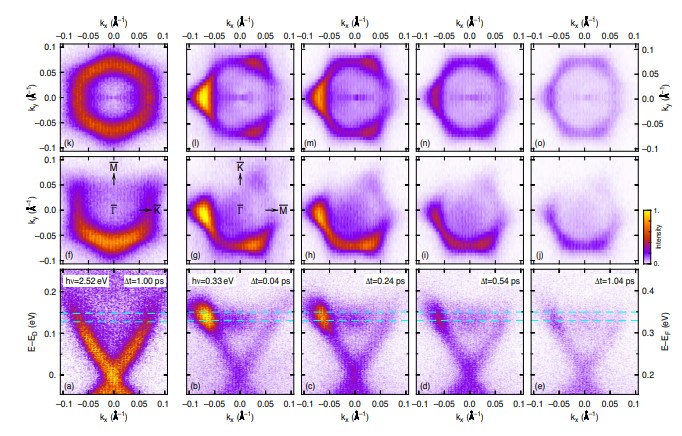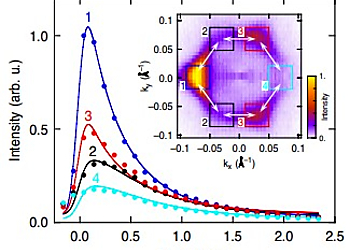Ultrafast Electron Dynamics in a Topological Surface State Observed in Two Dimensional Momentum Space
Result of the Month
Here, we present the investigation of the ultrafast population dynamics in the topological surface state (TSS) of Sb2Te3 after direct optical excitation by mid-IR pulses in the full 2D momentum space. We will show that the excitation is strongly enhanced along three of the six Γ–M directions, which allows us to monitor the subsequent redistribution of the electrons within the whole Dirac cone in unprecedented detail. We find that the enhancement significantly differs along these three directions, if a mirror plane (Γ–M direction) of the sample surface is oriented perpendicular to the plane of light incidence. This confirms that the excitation by linearly polarized mid-IR pulses can in fact generate a macroscopic photocurrent which is automatically spin polarized due to the spin texture of the TSS.
Photoelectrons were collected by a hemispherical analyser (Scienta DA30-L) equipped with deflection plates in the electron lens which makes it possible to acquire energy-momentum (E–kx) maps with the electron momentum kx oriented along the entrance slit of the hemisphere for varying momentum ky (perpendicular to kx). In this way, the ultrafast dynamics of the optically excited population in the initially unoccupied band structure can be sequentially mapped in the full two-dimensional momentum space of the sample surface without moving the sample.

Angle-resolved 2PPE data of Sb2Te3excited by visible (hn=2.52) and mid-IR (hν=0.33) pump pulses. (a) E–kx map for 2.52-eV excitation and kx along Γ–K at a pump-probe delay of Δt=1 ps. (b–e) For 0.33-eV excitation and kx along Γ–K at different pump-probe delays as indicated. (f–j) Corresponding kx–ky maps integrated over energy intervals centered at E−ED=140 meV as is depicted by the cyan dashed lines in (a–e). (k–o) The same cuts as (f–j) but with the intensity corrected for the matrix element of the probe transition and symmetrized by mirroring the data at the kx-axis. For all data, the plane of light incidence is oriented along the ky-axis.
(The final published version of this work is available here)

